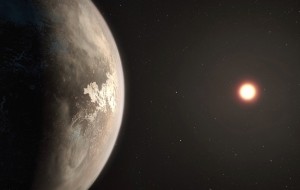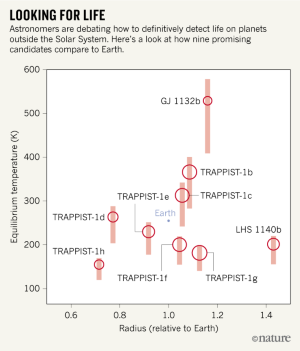Astronomers expand ideas of how chemistry and geology could affect chances for life on other worlds.
Laramie, Wyoming

Steve Desch can see the future of exoplanet research, and it’s not pretty. Imagine, he says, that astronomers use NASA’s upcoming James Webb Space Telescope to scour the atmosphere of an Earth-mass world for signs of life. Then imagine that they chase hints of atmospheric oxygen for years — before realizing that those were false positives produced by geological activity instead of living things.
Desch, an astrophysicist at Arizona State University in Tempe, and other planet hunters met from 13-17 November in Laramie, Wyoming, to plot better ways to scout for life beyond Earth. Many are starting to argue that the standard definition of habitability — having liquid water on a planet’s surface — is not the factor that should guide exoplanet exploration. Instead, the scientists say, the field should focus on the chances of detecting alien life, should it exist.
“Planets can be habitable and not have life with any impact,” Desch told researchers at the meeting.
It turns out that water worlds may be some of the worst places to look for living things. One study presented at the meeting shows how a planet covered in oceans could be starved of phosphorus, a nutrient without which earthly life cannot thrive. Other work concludes that a planet swamped in even deeper water would be geologically dead, lacking any of the planetary processes that nurture life on Earth.
“Habitability is not only about finding the signature of an alien life form taking a deep breath,” says Elizabeth Tasker, an astronomer and exoplanet researcher at the Japan Aerospace Exploration Agency's Institute for Space and Aeronautical Sciences in Sagamihara. It’s also about how a planet’s geology and chemistry interconnect to create a welcoming or hostile environment, she says — complicating the search for extraterrestrial life.
Surf and turf
Astronomers have catalogued thousands of exoplanets, of which more than a dozen are potentially habitable. The most recent, announced on 15 November, is Ross 128b, which is 3.4 parsecs (11 light years) away from Earth. It resembles the target that scientists have spent decades hunting: an Earth-sized planet orbiting a nearby star, probably at the right distance to allow liquid water.
Most of these planets have some qualities that stop them from being true Earth twins. Ross 128b orbits a cool dwarf star rather than a Sun-like host, for instance. But Tasker says the usual metrics that scientists use to rank how habitable a world is, such as its location relative to its star or how closely it resembles Earth, are misguided1.
To figure out how to parcel out valuable observing time, some scientists suggest targeting planets that, like Earth, are thought to have a mix of ocean and land. That's because worlds with nothing but water on their surfaces may not have key nutrients available in forms that can support life — if it is based on the same chemistry as life on Earth.
“We have this stereotype that if we have oceans, we have life,” says Tessa Fisher, a microbial ecologist at Arizona State. But her recent work contradicts this idea. Fisher and her colleagues studied what would happen on an “aqua planet” with a surface that is almost or completely covered by enough water to fill Earth’s oceans five times.
On Earth, rainwater hitting rocks washes phosphorus and other nutrients into the oceans. But without any exposed land, there is no way for phosphorus to enrich water on an aqua planet over time, Fisher reported at the Laramie meeting. There would be no ocean organisms, such as plankton, to build up oxygen in the planet’s atmosphere, she says — making this type of world a terrible place to find life.

Wet blanket
The wettest planets would run into a different sort of trouble, says Cayman Unterborn, a geologist at Arizona State who analysed the planet-wide effects of having as much as 50 Earth oceans’ worth of water. The sheer weight of all that liquid would exert so much pressure on the sea floor that the planet’s interior would not melt at all, Unterborn found.
Planets need at least some internal melting to sustain geological activity, such as plate tectonics, and to provide the right geochemical environment for life. In this case, Unterborn says, “too much water is too much of a good thing.”
Water-rich worlds are easy to make. Many planets are likely to have formed far from their parent star, Tasker says, in chilly temperatures where they could have coalesced from fragments of rock and lots of ice. If such a planet later migrated closer to its star, the ice would melt and cover the surface in vast oceans. Some of the seven small planets orbiting the star TRAPPIST-1, which is 12.6 parsecs (41 light years) from Earth, are thought to have substantial water on their surfaces2.
Instead of instinctively studying such water worlds, Tasker says, astronomers need to think more deeply about how planets have evolved through time. “We need to look carefully at picking the right planet,” she says.
The James Webb Space Telescope is set to launch in 2019. Once in space, the telescope will spend much of its time studying potentially Earth-like worlds. Researchers have already begun to analyse how oxygen, methane or other ‘biosignature’ gases in exoplanet atmospheres might appear to the telescope’s view3.
Towards the end of the Laramie meeting, attendees voted on whether scientists will find evidence of life on an exoplanet by 2040. They were not optimistic: 47 said no and 29 said yes. But a greater share was willing to bet that life would be found on another world in the 2050s or 2060s.
That's presumably enough time to work through the debate over which worlds are the best to target.
Change history
20 November 2017
This story misstated the outcome of the vote at the Laramie meeting as 47% no to 29% yes. In fact, the result was 47 votes yes, 29 votes no.
References
Tasker, E. et al. Nature Astron. 1, 0042 (2017).
Bourrier, V. et al. Astron. J. 154, 121 (2017).
Morley, C. V., Kreidberg, L., Rustamkulov, Z., Robinson, T. & Fortney, J. J. Preprint at http://arxiv.org/abs/1708.04239 (2017).
Related links
Related links
Related links in Nature Research
These seven alien worlds could help explain how planets form 2017-Feb-22
Earth-sized planet around nearby star is astronomy dream come true 2016-Aug-24
Planet hunters seek new ways to detect alien life 2016-Jul-27
The truth about exoplanets 2016-Feb-17
The exoplanet files 2015-Nov-18
Climate scientists join search for alien Earths 2015-Apr-17
Related external links
Rights and permissions
About this article
Cite this article
Witze, A. Exoplanet hunters rethink search for alien life. Nature 551, 421–422 (2017). https://doi.org/10.1038/nature.2017.23023
Published:
Issue Date:
DOI: https://doi.org/10.1038/nature.2017.23023
